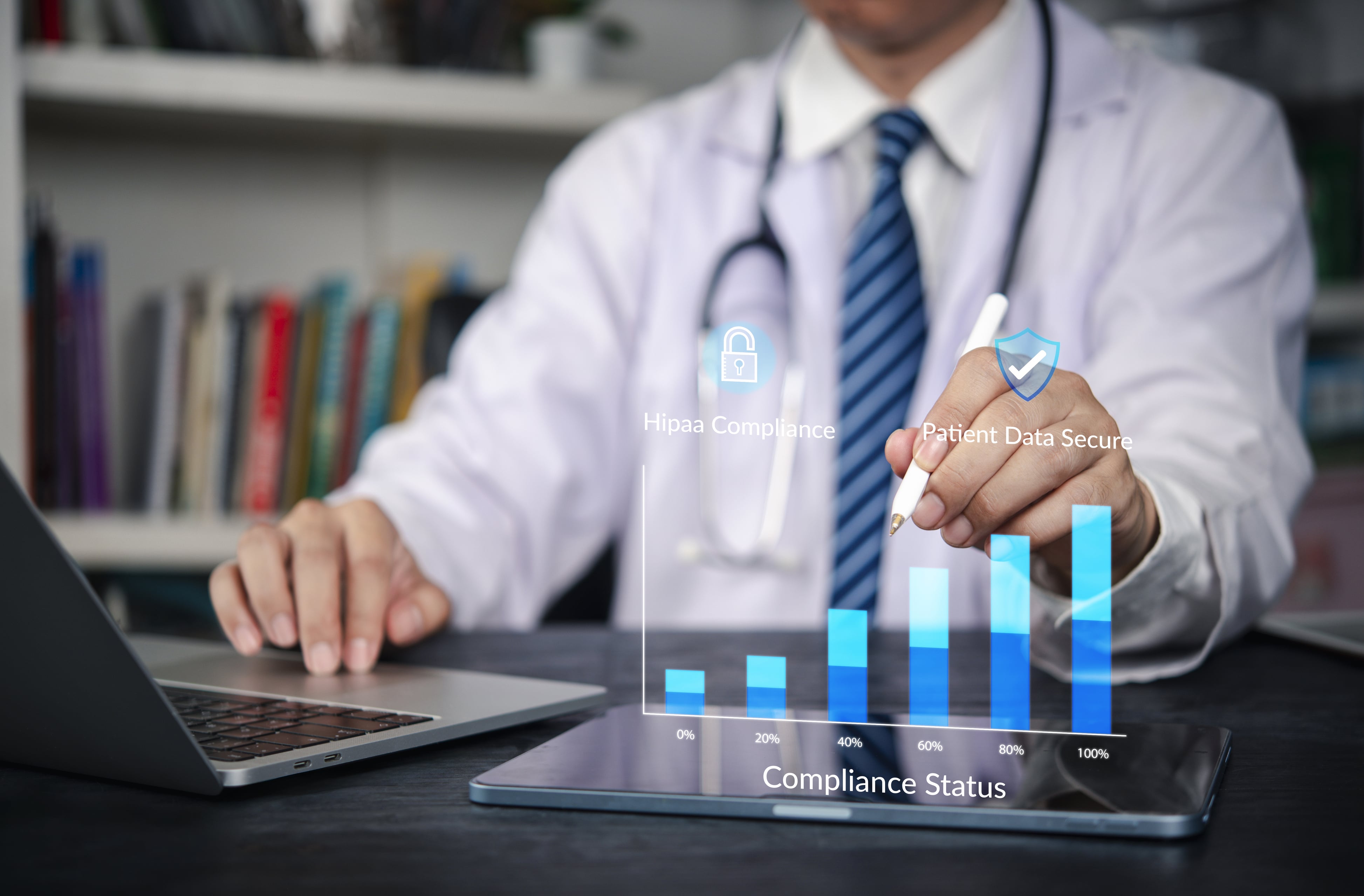Is Your Clinical Communication Platform Fully Compliant?

For healthcare providers, compliance means ensuring that every exchange of patient information follows strict privacy, security, and operational standards set by healthcare regulations, such as HIPAA and PHIPA.
Non-compliance can result in substantial financial penalties, reputational damage, and loss of trust with patients. Beyond fines, insecure communication tools can slow down clinical workflows, introduce errors, and ultimately compromise patient safety.
In this article, we’ll discuss the importance of healthcare compliance, essential compliance features to look for in a clinical communications platform, and how to ensure your organization’s clinical communications platform and processes are healthcare compliant.
Why Compliance Matters in Healthcare
Healthcare regulations such as HIPPA and PHIPA were created to ensure the confidentiality, security, and integrity of patient information. Below are a few reasons why using a compliant clinical communication platform is non-negotiable.
1. Protecting patient data & trust
Protecting sensitive patient information is the foundation of healthcare privacy regulations, but it’s also critical to maintain patient trust – especially as people are increasingly apprehensive about how their personal data is shared.
A 2022 survey conducted by the American Medical Association found that 75% of people are concerned about protecting the privacy of their health data. This feeling is underscored by the alarming fact that in 2024, the protected health information (PHI) of over 276 million individuals in the US was exposed or stolen as a result of healthcare data breaches.
Using compliant communication platforms safeguards PHI and helps maintain patient confidentiality and trust – which is critical to deliver the best care.
2. Reducing legal and financial risk
HIPAA penalties cost anywhere from $100-$50,000 per violation. Using non-compliant tools, such as consumer messaging apps, increases the risk that providers may unknowingly be violating compliance.
While compliance regulations were created to protect patient confidentiality, they’re also meant to provide safeguards from costly and dangerous healthcare data breaches. In 2023, cybersecurity breaches cost the healthcare industry $10.93 million.
Healthcare organizations must use compliant platforms that provide encryption and auditable logs in order to meet regulatory requirements and avoid costly fines or legal risks.
Understanding Compliance Standards
In the US, healthcare providers must be HIPAA-compliant, while those in Ontario, Canada must adhere to PHIPA compliance standards. Compliance with HIPAA and PHIPA means that an organization follows strict standards to protect patient data. This includes secure storage, encrypted communication, access controls, and audit trails.
What is HIPAA Compliance?
HIPAA compliance is the process of following the federal privacy regulations set by the Health Insurance Portability and Accountability Act of 1996 (HIPAA). Created and regulated by the US Department of Health and Human Services (HHS), and enforced by the Office for Civil Rights (OCR), HIPAA was created to set national standards to protect patient health information (PHI). HIPAA compliance is required for healthcare providers and health insurance companies in the US.
What is PHIPA Compliance?
PHIPA compliance requires healthcare providers in Ontario, Canada to adhere to the regulations set by the Personal Health Information Protection Act (PHIPA). PHIPA is part of the Health Information Protection Act and regulates the collection, use, and disclosure of personal health information by a "Health Information Custodian" (HIC) – this includes healthcare providers such as hospitals, doctors, and pharmacies.
Other Compliance Standards
While HIPPA and PHIPA are the primary compliance standards for US and Ontario-based healthcare organizations, there may be more regulations to comply with, depending on where your hospital operates:
- General Data Protection Regulation (GDPR): An EU law, GDPR mandates how personal data is collected, processed, stored, and shared. It’s applicable to any organization that processes the personal data of EU residents.
- Personal Information Protection and Electronic Documents Act (PIPEDA): A federal privacy law, PIPEDA applies to private sector organizations across Canada that collect, use, or disclose personal information in the course of commercial activity.
- Health Information Act (HIA): The Health Information Act is a law in Alberta that regulates the collection, use, disclosure, and access to individual health information. HIA applies to custodians of health information such as hospitals and providers.
- FIPPA: The Freedom of Information and Protection of Privacy Act is a privacy law mandated in British Columbia that applies to public bodies such as hospitals.
- PIPA: British Columbia also has another privacy legislation called Personal Information Protection Act, which applies to private health practitioners.
Critical Compliance Features
There are several features to look for in a clinical communications platform to ensure compliance with HIPAA and PHIPA. We’ll start with the non-negotiable functions that are required for healthcare compliance.
1. Secure messaging
The basis of both HIPAA and PHIPA is the requirement that personal health information be collected, used, and disclosed within secure systems. Consumer messaging platforms such as WhatsApp, Slack, Signal, or SMS lack the technical safeguards – including audit logs and role-based access controls – needed to protect this information.
Look for clinical communication platforms that offer secure, real-time messaging to meet healthcare regulatory standards. Features should reduce unauthorized access risks and ensure that sensitive patient information such as conversations about diagnoses, treatments, and patient records remain confidential and protected.
A key component of secure messaging compliance is end-to-end encryption. Encryption – both in transit and at rest – ensures that even if messages or data are intercepted, they are unreadable to unauthorized parties. This reduces the risk of costly data breaches.
2. Administrative controls and audit trails
Unauthorized access – which includes employee errors and negligence – is one of the contributing factors to healthcare data breaches, which put patient data at risk.
With administrative controls such as role-based access, providers see only the information they need to perform their job. By limiting unnecessary access to PHI, hospitals reduce exposure risks and stay aligned with the “minimum necessary” standard under HIPAA. This is also essential for maintaining operational discipline across large care teams.
Every message, access point, and data exchange should be logged. Detailed audit trails enable compliance officers to track communication patterns, investigate incidents, and demonstrate regulatory adherence during audits. Features such as message expiration and remote wipe also reinforce security – all of which are critical for accountability and risk management.
Additional Compliance Related Features to Look for in a Communication Platform
In addition to the critical functions required to remain compliant, there are several features to consider in a clinical communications platform that can enhance security, accountability, and compliance-related issues.
1. Priority indicators, read receipts, and escalation pathways
Healthcare compliance regulations require timely and accurate access to PHI. Clinical communication tools that offer features such as priority indicators, read receipts, and escalation pathways make it easier to send secure messages and execute real-time communication.
For instance, Hypercare’s secure messaging platform includes priority indicators that override silent and do-not-disturb settings on mobile devices. It also confirms whether a message has been read and allows urgent communications to escalate automatically if unanswered. These features not only support compliance with clinical communication standards but also helps mitigate liability in high-risk situations where delays could compromise patient care.
Additionally, these features ensure that patient information is relayed to the right providers, which helps reduce risks of miscommunication or sensitive data getting in the wrong hands.
2. Structured templates
Pre-approved message templates with customizable response types help prevent accidental disclosure of non-permitted PHI, reduce the risk of human error, and reinforce consistency across departments.
By standardizing communication for common workflows – such as patient updates, discharge summaries, or critical test results – providers can ensure compliance with hospital policies and healthcare regulations. Streamlined communications make it easier for compliance officers to conduct regular audits.
3. Integration and interoperability
Platforms that seamlessly integrate with existing clinical tools help meet the requirement for timely and accurate access to PHI. Interoperable platforms further reduce redundant documentation and manual workarounds, freeing up the clinical team’s time for better patient care.
Additionally, integrated systems help ensure that clinicians are working from a single source of truth, reducing inconsistencies and ensuring that PHI is shared only through approved, secure pathways.
4. User experience and scalability
A cumbersome tool with poor usability can lead staff to revert to insecure channels – such as SMS or consumer messaging apps – putting sensitive information at risk.
To ensure usability and make it easier for clinical teams to adopt, clinical communications platforms should be intuitive, mobile-first, and able to scale across departments, facilities, and health systems.
Scalability ensures that as your organization grows, the platform can adapt without compromising compliance or workflow efficiency.
Evaluating the Compliance of Your Current Clinical Communication Platform
Below is a clinical communication compliance checklist to follow when evaluating your existing platform.
1. Conduct a compliance audit
Start by conducting a comprehensive compliance audit of your organization’s existing clinical communications infrastructure. Key stakeholders from IT, compliance, legal, and clinical should be involved to ensure every area is covered.
For the audit, document where data is created, stored, transmitted, logged, and who – both internally and externally – can access it. Then, map every flow of electronic PHI through the platform, from sender to message to storage, and including integrations such as EHR, labs, imaging, and single sign-on (SSO).
Your compliance audit should also answer the following questions:
- What encryption do we use?
- How are role-based permissions managed?
- Are audit trails comprehensive?
- Do you have procedures in place to handle data compromises?
2. Compare to compliance standards and security best practices
Once you’ve documented how your current platform handles compliance, measure those findings against industry standards, starting with authoritative regulations.
HIPAA requires healthcare organizations in the US to implement administrative, physical, and technical safeguards, while PHIPA sets out similar requirements for custodians. Mapping your audit results against these frameworks gives you a clear view of whether your current setup meets, exceeds, or falls short of regulatory expectations.
Beyond regulatory guides, look to independent certifications as proof points. Frameworks such as SOC 2 Type II provide external validation that a platform’s security and privacy controls are working effectively. A platform that can provide these certificates signals that the vendor prioritizes compliance and aligns with healthcare standards.
3. Use a clinical communication platform evaluation checklist
The final step is to put your evaluation into practice with a structured checklist.
Following a comprehensive checklist ensures nothing slips through the cracks and provides a clear, repeatable way to measure compliance. At a minimum, verify that your platform has a signed Business Associate Agreement (BAA) – a HIPAA requirement. It must also use strong encryption for data in transit and at rest, comply with data residency requirements, enforce role-based access controls, and maintain detailed audit logs. These are essential for meeting HIPAA and PHIPA requirements.
If your audit reveals the need for a new clinical communication platform, use this vendor evaluation checklist to find the right platform for your organization.
Real‑World Impact of Compliance in Healthcare Settings
Below are real examples of how using compliant clinical communication platforms has transformed how healthcare providers communicate in clinical settings and deliver better, more coordinated patient care.
Switching to a compliant, secure messaging system
When healthcare provider Jack & Jill Health began operating remotely, communication became inefficient and providers had to rely on phone calls or email. If those conversations involved sensitive patient data, it would have to be coded to ensure data privacy. Additionally, the team was using Slack as their internal messaging solution, but they grew tired of masking patient data and not being able to discuss patients directly and compliantly.
Jack & Jill partnered with Hypercare to implement a PHIPA-compliant platform and solve its workflow inefficiencies. Since partnering with Hypercare, Jack & Jill has seen significant improvements in efficiency for patient care coordination. The team uses the platform’s group chat functionality to help improve cross team collaboration and analyze patient data together and closed-loop communication ensures that action items don’t fall through the cracks.
“Hypercare has helped improve communication efficiency by approximately 10-20%,” says Bukhtar Khan, Head of Growth at Jack & Jill.
Reduced code activation times
When Mile Bluff Medical Center began the search for a clinical communication platform that matched the urgency and complexity of its growing hospital system, one of the primary goals was to support secure, HIPAA-compliant communication between any team, anywhere. The hospital lacked a secure messaging channel to use across departments, leaving them at risk for non-compliant communication.
After implementing Hypercare’s real-time messaging, scheduling, and surgical activation workflows across its organization, Mile Bluff saw activation time for emergency surgeries decrease from from 20-30 minutes to just five seconds. The team also sent over 70,000 secure messages in the first six months and reported dramatic reductions in miscommunication and coordination delays.
Adoption of secure, healthcare compliant messaging
When Sault Area Hospital sought the need for a modern, secure scheduling and communication platform, the organization turned to Hypercare. The hospital specifically needed a compliant way to share secure messages such as images and results.
Physicians began using Hypercare as their primary communication tool for consults, preferring secure messaging over phone calls. This shift has made Hypercare a valuable platform for improving consult efficiency while ensuring data protection.
“Hypercare has made a real difference in how we communicate during consults,” says Dr. Derek Garniss, CMIO at SAH. “Being able to securely message and share images and results right from my phone has made my workflow significantly more efficient.”
Ensuring Healthcare Compliance
Adhering to compliance regulations set by HIPAA in the US and PHIPA in Ontario is non-negotiable for healthcare providers. Using compliant communication tools is not only critical to protect patient health information, but also to safeguard your clinical team and the integrity of your organization.
Assess your existing clinical communication tools to ensure compliance. Prioritize features such as secure messaging with encryption, administrative controls, audit trails, and interoperability. For enhanced evaluation, download Hypercare’s vendor evaluation checklist or book a demo to learn how Hypercare’s all‑in‑one solution can be used as a benchmark for compliance and efficiency.
Read more of our posts

Nov 7, 2025 • 4 min read
Challenges and Risks with Data Interoperability in Healthcare
Healthcare interoperability – the ability of different information systems, devices, and applications to access, exchange, and cooperatively use data in a coordinated manner – is essential for overcoming fragmented care. However, the challenges of data interoperability in healthcare include technical barriers, financial constraints, privacy concerns, and cultural resistance that can impede on clinical teams’ ability to achieve true interoperable success.

Oct 31, 2025 • 7 min read
What are the Four Levels of Interoperability in Healthcare?
Healthcare interoperability is critical for connected care clinical workflows. Interoperability enables the flow of information between systems, ensuring that information is not only sent and received but also understood and standardized.

Oct 30, 2025 • 6 min read
How to Improve Interoperability in Healthcare
Healthcare systems are traditionally fragmented. Patient health information must travel from one provider to another, across different systems, and be interpreted correctly by the receiver. All of these steps emphasize the importance of establishing interoperability within your healthcare organization. Improving interoperability in healthcare is critical to protect patient safety, improve operational efficiency, and remain compliant with evolving regulations.
Ready to learn more?
Get an in-depth product tour to see what Hypercare can do for your team
Hypercare helps hundreds of clinical teams and healthcare organizations across North America coordinate and collaborate seamlessly, with one single clinical communication platform. Let us show you how we can help.
